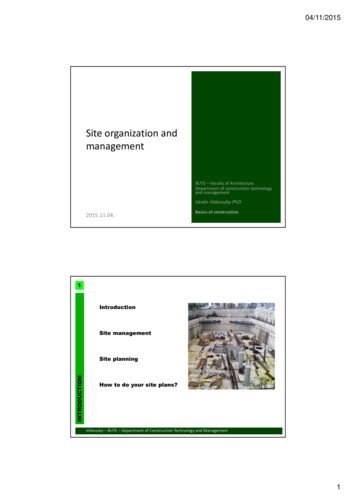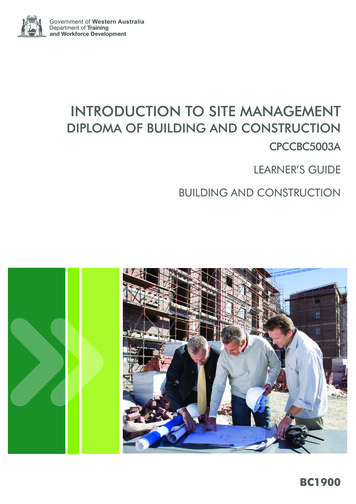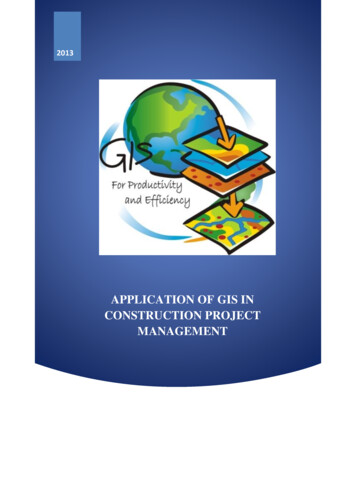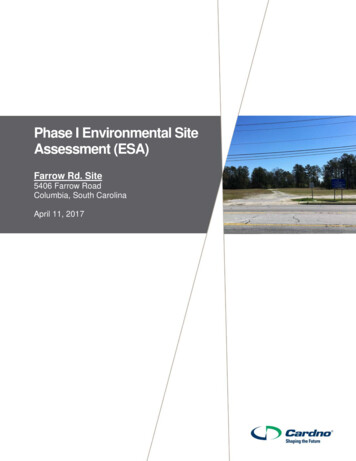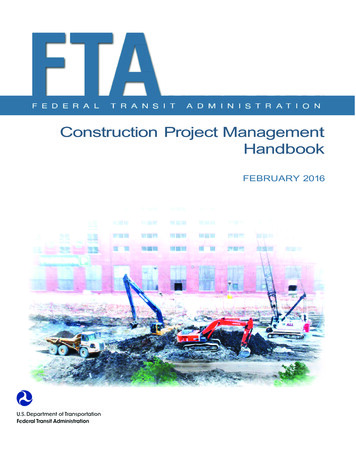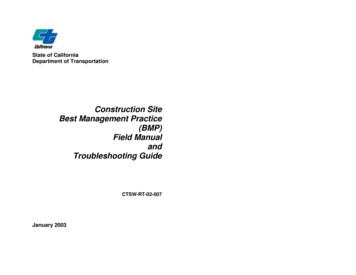
Transcription
State of CaliforniaDepartment of TransportationConstruction SiteBest Management Practice(BMP)Field ManualandTroubleshooting GuideCTSW-RT-02-007January 2003
Construction Site BMPs Field Manual and Troubleshooting GuideTABLE OF CONTENTSPART I: INTRODUCTION. 1Principles of Erosion and Sediment Control . 2Common Pollutants on the Construction Site. 4Monitoring and Inspection Program. 6PART II: PROJECT OPERATIONS AND BMPS . 12PART III: BMP IMPLEMENTATION ANDTROUBLESHOOTING . 17TEMPORARY SOIL STABILIZATION . 17SS-2Preservation of Existing Vegetation. 17SS-3Hydraulic Mulch . 19SS-4Hydroseeding . 22SS-5Soil Binders. 25SS-6Straw Mulch. 28SS-7Geotextiles, Plastic Covers, Erosion Control Blankets &Mats. 30SS-8Wood Mulching . 34SS-9Earth Dikes, Drainage Swales & Ditches. 36SS-10 Outlet Protection/Velocity Dissipation Devices. 39SS-11 Slope Drains. 41TEMPORARY SEDIMENT CONTROL . 43SC-1Silt Fence. 43SC-2Desilting Basin . 47SC-3Sediment Trap . 49SC-4Check Dam. 52SC-5Fiber Rolls. 55SC-6Gravel Bag Berm. 58SC-7Street Sweeping and Vacuuming . 60SC-8Sandbag Barrier. 62SC-9Straw Bale Barrier. 66SC-10 Storm Drain Inlet Protection . 70WIND EROSION CONTROL . 73WE-1 Wind Erosion Control . 73TRACKING CONTROL . 75TC-1 Stabilized Construction Entrance/Exit . 75TC-2 Stabilized Construction Roadway . 78NON-STORM WATER MANAGEMENT . 80NS-1 Water Conservation. 80NS-2 Dewatering Operations. 82NS-3 Paving and Grinding Operations . 85NS-4 Temporary Stream Crossing. 88i
Construction Site BMPs Field Manual and Troubleshooting GuideNS-5 Clear Water Diversion. 91NS-7 Potable Water/Irrigation . 94NS-8 Vehicle and Equipment Cleaning. 96NS-9 Vehicle and Equipment Fueling . 98NS-10 Vehicle and Equipment Maintenance. 101NS-11 Pile Driving Operations. 103NS-12 Concrete Curing . 105NS-13 Material and Equipment Use on Water . 107NS-14 Concrete Finishing . 109NS-15 Structure Demolition/removal Over or Adjacent to Water111NS-16 Temporary Batch Plants . 113NS-17 Streambank Stabilization. 115WASTE MANAGEMENT AND MATERIALS POLLUTIONCONTROL. 117WM-1 Material Delivery and Storage. 117WM-2 Material Use . 120WM-3 Stockpile Management . 122WM-4 Spill Prevention and Control . 124WM-5 Solid Waste Management. 127WM-6 Hazardous Waste Management . 130WM-7 Contaminated Soil Management . 133WM-8 Concrete Waste Management. 135WM-9 Sanitary/Septic Waste Management. 138WM-10 Liquid Waste Management . 140LIST OF TABLESTable 1Storm Water BMPs for Construction Operations. 12ii
IntroductionPART I:INTRODUCTIONThis document provides a toolbox for Caltrans field personnel toaid in proper implementation of water pollution control BestManagement Practices (BMPs) on the construction site. Thedocument is organized into the following parts: Part I: Introduction briefly presents (1) the principles oferosion and sediment control, (2) common storm waterpollutants on the construction site, and (3) guidelines forimplementing a proper monitoring and inspection programfor the construction site, including the use of the StormWater Pollution Prevention Plan (SWPPP) or WaterPollution Control Program (WPCP) to ensure an effectivewater pollution control program. Part II: Project Operations and BMPs identifies typicalwater pollution control challenges for specific constructionoperations and the BMPs that are available to meet thosechallenges. Part III: BMP Implementation and Troubleshootingprovides guidance for installing, maintaining andtroubleshooting selected BMPs from the Caltrans StormWater Quality Handbooks, Construction Site BMPs Manual.1
IntroductionPRINCIPLES OF EROSION AND SEDIMENT CONTROLThe greatest water pollution threat from soil-disturbing activitiesis the introduction of sediment from the construction site intostorm drain systems or natural receiving waters. Soil-disturbingactivities such as clearing, grubbing, and earthwork increase theexposure of soils to wind, rain, and concentrated flows that causeerosion. A three-pronged approach is necessary to combat thisstorm water threat: Temporary soil stabilization practices reduce erosionassociated with disturbed soil areas (DSAs). Temporary run-on control practices prevent storm waterflows (sheet and concentrated) from contacting DSAs. Temporary sediment control practices reduce sedimentcaused by erosion from entering a storm drain system orreceiving water.Soil stabilization BMPs reduce the erosive impact of rain onexposed soil. Run-on control practices reduce the erosiveimpacts by preventing storm water flows from contacting DSAs.Sediment control BMPs remove sediment from storm water byponding and settling, and/or filtering prior to discharge offsite. Itis imperative that soil stabilization and sediment control BMPsare implemented together to reduce the discharge of sedimentfrom the construction site.The following conditions on construction sites contribute toerosion caused by storm water flows: Larger areas of impermeable structures and surfaces reducenatural infiltration resulting in increased storm water flowvolume and velocity. Changes to surface flow patterns cause storm water flows tobe more erosive. Concentration of flows to areas that are not naturallysubjected to such runoff volume increases erosion.2
IntroductionProper management of a construction project minimizes orprevents soil erosion and sediment discharges. Goodconstruction management for soil conservation requires anunderstanding of the following basic principles:Soil Erosion Control – The First Line of DefenseSoil stabilization is a key component in the control oferosion. By stabilizing DSAs with covers or binders, theexposed soils are less likely to erode from the effects of windor rain.Prevent Storm Water Flows from Contacting DSAs – TheSecond Line of DefenseAnother key component in the control of erosion is thediversion of storm water flows around DSAs or theconveyance of flows through DSAs in a non-erosive manner.Sediment Control – The Last Line of DefenseStorm water runoff may originate from active or inactiveDSAs whether or not proper erosion and/or run-on controlshave been implemented. Implementing proper sedimentcontrol BMPs can reduce sediment amounts in storm waterdischarges.Combine Soil Erosion and Sediment Control – EffectiveProtectionAn effective combination of soil erosion and sedimentcontrols should be implemented to prevent sediment fromleaving the site and/or entering a storm water drainagesystem or receiving water.Soil stabilization and other erosion control BMPs are not 100percent effective at preventing erosion. Soil erosion controlBMPs must be supported by sediment control BMPs tocapture sediment on the construction site.Sediment control BMPs alone are not 100 percent effectiveprimarily due to their capacity limits. To be effective forstorm water protection, the amount of sediment must bereduced at the source using soil erosion control BMPs, and3
Introductionthen sediment control BMPs are used to further reduce thesediment that leaves the site or enters the storm drain system.Inspection and Maintenance – Ensure Protection for theDuration of the ProjectInspection and maintenance are required for all BMPs (soilstabilization, run-on control, and sediment control) tomaintain effectiveness for reducing or eliminating theamount of sediment that leaves a site.COMMON POLLUTANTS ON THE CONSTRUCTION SITEThere are a number of potential storm water pollutants that arecommon to Caltrans construction sites. The soil-disturbingnature of construction activities and the use of a wide range ofconstruction materials and equipment are the sources ofcontaminants with the potential to pollute storm waterdischarges.Common construction activities that increase the potential forpolluting storm water with sediment include: Clearing and grubbing operations Demolition of existing structures Grading operations Soil importing and stockpiling operations Clear water diversions Landscaping operations Excavation operationsCommon construction materials with the potential to contributepollutants, other than sediment, to storm water include thefollowing: Vehicle fluids, including oil, grease, petroleum, and coolants Asphalt concrete (AC) and Portland cement concrete (PCC)materials and wastes Joint seal materials and concrete curing compounds Paints, solvents, and thinners4
Introduction Wood products Metals and plated products Fertilizers, herbicides, and pesticidesConstruction-related waste must also be managed to prevent itsintroduction into storm water. Typical waste on constructionsites includes: Used vehicle fluids and batteries Wastewater from vehicle cleaning operations Green waste from vegetation removal Non-storm water from dewatering operations Trash from materials packaging, employee lunch/mealbreaks, etc. Contaminated soils Slurries from sawing and grinding operations Wastewater/waste from concrete washout operations Hazardous materials waste Sanitary waste5
IntroductionMONITORING AND INSPECTION PROGRAMThe Resident Engineer is responsible for ensuring that Caltranspersonnel monitor the contractor’s water pollution controlpractices and maintain compliance with the approved projectSWPPP/WPCP. This includes reviewing the contractor’sSWPPP/WPCP, reviewing written inspection reports, andconducting field inspections. Caltrans Structures personnelshould also be aware of the water pollution control requirementsand participate in the monitoring program.Step 1: Do Your Homeworka. Review the Storm Water Quality Handbooks:Construction Site BMPs Manual.Caltrans personnel with storm water responsibilitiesshould familiarize themselves with BMP requirements.In particular, become familiar with (1) the rainy seasondates for your geographical area, (2) the definitions ofDSA, active DSA, and non-active DSA, and (3) therequirements for soil stabilization and sediment controlBMPs for the season and specific Rainfall Area.b. Review the Project Plans.Review the Project Plans in the context of storm waterpollution control. Visualize storm water run-on andrunoff flow patterns when reviewing the plans. Reviewthe general layout and existing drainage courses. Identifypotential problem areas where storm water may run ontothe site or discharge off site.Identify the locations where structures are beingconstructed or modified. Be familiar with the right-ofway and easement limits. Determine the limits ofclearing and grubbing activities. Identify the projectphase or stage. Try to determine DSAs andEnvironmentally Sensitive Areas (ESAs). Is the nextphase going to include soil-disturbing activities and is itscheduled within the rainy season? Do the DSAs haveprovisions in the plans for permanent erosion control?Determine if permanent erosion control can be placedwhen activity in the DSA is complete.6
Introductionc. Review the Special ProvisionsReview the Special Provisions for site-specific waterpollution control requirements such as: (1) permits forthe construction project, (2) limits on active DSAs, (3)rainy season dates and requirements, (4) minimum BMPrequirements, (5) BMP maintenance and inspectionrequirements, and (6) final erosion control requirements.Final erosion control requirements include (1) requiredproducts, (2) application process, (3) application rate,(4) seeding window, and (5) planting requirements.The Special Provisions also include a section on waterpollution control permits or requirements imposed on theproject by other agencies. Typical agencies include theCalifornia Department of Fish and Game, Army Corpsof Engineers, local flood control agencies, and others.There may be special requirements for water bodies orESAs that need special water pollution controlconsideration.Review the Special Provisions bid items related to waterpollution control. There may be lump sums or unit pricesfor water pollution control items includingSWPPP/WPCP preparation, permanent erosion control,and temporary erosion and sediment controls.Review the Special Requirements section of the SpecialProvisions for site-specific activities such as: (1)dewatering, (2) sampling and analysis, (3) BMPmaintenance cost allocation between Caltrans and thecontractor, and (4) sanctions against the contractor in theevent of non-compliance with the water pollution controlrequirements.d. Review the SWPPP/WPCP.The SWPPP or WPCP for the project is the contractor’splan to ensure conformance with Caltrans’ waterpollution control requirements on the construction site.The SWPPP/WPCP contains details about the BMPs tobe used on the site, their locations, implementationtimeframes, and inspection and maintenance schedules.7
IntroductionThe contractor must comply with the approvedSWPPP/WPCP. If conditions change on the constructionsite that impact storm water pollution controls, thecontractor must amend the SWPPP/WPCP.In the SWPPP, Section 200 contains the approvalsignature and lists any amendments. Section 300describes unique features of the construction site andcontains the construction and water pollution controlschedules. Section 500 identifies the BMPs selected forsoil stabilization, sediment control, non-storm watercontrols, waste management, and materials disposalcontrols and references locations on the vicinity map andwater pollution control drawings.In a WPCP, Section 10 contains the approval signatures.Section 20 describes the unique features of the site andcontains the schedule. Section 30 identifies the selectedBMPs, the vicinity map and water pollution controldrawings. Section 40 contains any WPCP amendments.e. Review the Contractor’s Schedule.The accepted Baseline schedule as well as the monthlyupdates and three-week “look-ahead” schedules areimportant references to better anticipate which BMPswill be implemented or needed. A project schedule isrequired in both SWPPPs and WPCPs and must showhow the rainy season relates to soil-disturbing and restabilization activities and must also show majoractivities sequenced with implementation of BMPs.Step 2: Establish an Inspection Schedulea. Prior to the rainy season, inspect the site to ensure thatthe contractor has the necessary materials to stabilizerequired DSAs and to implement the necessary sedimentcontrols.b. Year round, inspect the construction site prior to aforecast storm, after a rain event that causes runoff fromthe construction site, and at 24-hour intervals during anextended rain event.8
Introductionc. Conduct inspections at other frequencies as required bythe Special Provisions.d. Work with the Project Storm Water Coordinator, theDistrict Construction Storm Water Coordinator, andSWTF Inspectors during site inspections and to receiveassistance when necessary.Step 3: Conduct the Inspectiona. Use the most recent Storm Water QualityConstruction Site Inspection Checklist to documentthe inspection. The checklist is provided in AttachmentH of the Caltrans Storm Water Quality Handbooks,SWPPP and WPCP Preparation Manual. This is thesame checklist used by the contractor for conductinginspections. Instructions for using the checklist are alsoprovided in Attachment H.b. Encourage the contractor to participate in the inspection.This provides the opportunity for verbal feedback anddiscussion.c. If the project involves significant structures work,encourage the Structures representative or inspector toparticipate in the inspection. Take a copy of the mostcurrent and approved site plan(s) and SWPPP on theinspection for identification of site features and fortaking notes at specific areas.d. Fill out the Inspection Checklist and add findings inwriting. Use clear and concise language and givespecific locations where problems were observed.e. Take photographs during the inspection to document theexisting conditions. This is especially important if thecontractor does not attend the inspection. When photosof problem areas are taken, try to follow up with photosshowing corrections.f.Inspect the entire site, including the perimeter, especiallywhere there is potential for run-on or discharge from thesite. Look for areas of potential concentrated flows andfor adjacent water bodies or drainage facilities that may9
Introductionbe affected by discharges from the site. Start theinspection at the lowest point, or the area with thehighest potential for discharge. Inspect all potentialdischarge points. The SWPPP/WPCP should identifydischarge points, however, there may be areas withdischarge potential that were not identified in theSWPPP/WPCP.g. Inspect the contractor’s yard(s), where required.h. Look for changes in construction or site conditions thatmay require an amendment to the SWPPP/WPCP.i.Inspect for proper implementation of non-storm watermanagement BMPs and waste management andmaterials pollution control BMPs.j.For inspections during the rainy season, evaluate activeand non-active DSAs. (The Resident Engineer shouldperiodically evaluate the classification of constructionareas as active DSAs or non-active DSAs.) Determinethe total area of DSA and compare it to the limit forDSAs in the Special Provisions. If the existing DSAexceeds the limit, identify areas that can be stabilized toreduce the amount. Active DSAs require protectionprior to the onset of rain. Evaluate erosion and sedimentcontrol BMPs based on the requirements related toRainfall Area, season and active/non-active status asdefined in the SWPPP/WPCP and BMP Manual. Besure to inspect the entire site during a rain event,especially when run-off from the site occurs. Conferwith the District Construction Storm Water Coordinatoras to the district’s definition of a rain event and maintainweather reports in the SWPPP file.k. During the non-rainy season, identify the active andnon-active DSAs. Depending on the Rainfall Area,DSAs may continue to require erosion and sedimentcontrol BMPs during the non-rainy season.l.For individual BMPs, note if the BMP is properlyinstalled. Also note if the BMP is in need of repair ormaintenance.10
IntroductionStep 4: Report Inspection Resultsa. If the Resident Engineer did not attend the inspection,communicate the results to the Resident Engineer.b. Ideally, observations should be discussed with thecontractor during the inspection.c. Missing BMPs and non-compliance issues must becommunicated to the contractor. Refer to thecontractor’s SWPPP/WPCP for required BMPs.Step 5: Follow-up with Corrective MeasuresThe contractor must install missing BMPs and correctimproperly installed or damaged BMPs immediately or by adate and time as approved in writing by the ResidentEngineer. In any event, corrections must be made prior to thenext rain event.11
Project Operations and BMPsPART II:PROJECT OPERATIONS ANDBMPSTable 1 identifies individual BMPs that are applicable to specificconstruction operations. The BMPs listed in the table are forgeneral consideration during each phase of operations. Theindicated BMPs may not be applicable to every constructionoperation, nor is every possible BMP listed for each constructionoperation. The Resident Engineer should determine theappropriateness of an individual BMP to a construction site.Table 1 Storm Water BMPs for Construction OperationsBMPs(See Part III for Details)ConstructionOperationSC-7Street Sweeping and VacuumingTC-1Stabilized Construction Entrance/ExitTC-2Stabilized Construction RoadwayTC-3Entrance/Outlet Tire WashNS-6Illicit Connection/ Illegal Discharge Detectionand ReportingWM-1Material Delivery and StorageWM-2Material UseWM-4Spill Prevention and ControlWM-5Solid Waste ManagementMobilizationWM-6Hazardous Waste ManagementWM-9Sanitary/Septic Waste Management12
Project Operations and BMPsBMPs(See Part III for S-6SS-7SS-11SchedulingPreservation of Existing VegetationHydraulic MulchHydroseedingSoil BindersStraw MulchGeotextiles, Plastic Covers & Erosion ControlBlankets/MatsWood MulchingEarth Dikes/Drainage Swales & Lined DitchesOutlet Protection/Velocity DissipationDevicesSlope t FenceDesilting BasinSediment TrapCheck DamFiber RollsGravel Bag BermStreet Sweeping and VacuumingSandbag BarrierStraw Bale BarrierStorm Drain Inlet ProtectionWE-1Wind Erosion ControlNS-1NS-8NS-9NS-10Water Conservation PracticesVehicle and Equipment CleaningVehicle and Equipment FuelingVehicle and Equipment MaintenanceWM-3WM-5WM-7Stockpile ManagementSolid Waste ManagementContaminated Soil ManagementSS-8SS-9SS-10Clearing/Grubbing13
Project Operations and BMPsBMPs(See Part III for S-6SS-7SS-11SchedulingPreservation of Existing VegetationHydraulic MulchHydroseedingSoil BindersStraw MulchGeotextiles, Plastic Covers & Erosion ControlBlankets/MatsWood MulchingEarth Dikes/Drainage Swales & Lined DitchesOutlet Protection/Velocity DissipationDevicesSlope t FenceDesilting BasinSediment TrapCheck DamFiber RollsGravel Bag BermStreet Sweeping and VacuumingSandbag BarrierStraw Bale BarrierStorm Drain Inlet ProtectionTC-1Stabilized Construction Entrance/ExitWE-1Wind Erosion -3WM-5WM-8Temporary Stream CrossingVehicle and Equipment CleaningVehicle and Equipment FuelingVehicle and Equipment MaintenanceContaminated Soil ManagementStreet Sweeping and VacuumingStabilized Construction Entrance/ExitPaving and Grinding OperationsMaterial Delivery and StorageMaterial UseStockpile ManagementSolid Waste ManagementConcrete Waste ManagementSS-8SS-9SS-10EarthworkPCC andACOperations14
Project Operations and BMPsBMPs(See Part III for -2SC-3SC-4SC-10Desilting BasinSediment TrapCheck DamStorm Drain Inlet ProtectionSS-9SS-10Earth Dikes/Drainage Swales & Lined DitchesOutlet Protection/Velocity Dissipation DevicesNS-2Dewatering WM-6WM-8WM-10Water Conservation PracticesPaving and Grinding OperationsTemporary Stream CrossingClear Water DiversionVehicle and Equipment CleaningVehicle and Equipment FuelingVehicle and Equipment MaintenanceMaterial Delivery and StorageMaterial UseStockpile ManagementSpill Prevention and ControlSolid Waste ManagementHazardous Waste ManagementConcrete Waste ManagementLiquid Waste ManagementPaving and Grinding OperationsTemporary Stream CrossingClear Water DiversionMaterial Delivery and StorageMaterial UseStockpile ManagementSolid Waste ManagementHazardous Waste ManagementConcrete Waste ManagementLiquid Waste Management15
Project Operations and BMPsBMPs(See Part III for hingOperationsErosionControl,HighwayPlanting andLandscapingSC-7SC-10Street Sweeping and VacuumingStorm Drain Inlet 8Stabilized Construction Entrance/ExitVehicle and Equipment CleaningVehicle and Equipment FuelingVehicle and Equipment MaintenanceMaterial Delivery and StorageMaterial UseStockpile ManagementSolid Waste ManagementHazardous Waste ManagementConcrete Waste ManagementSC-7SC-10WM-3Street Sweeping and VacuumingStorm Drain Inlet ProtectionStockpile eservation of Existing VegetationHydraulic MulchHydroseedingSoil BindersStraw MulchGeotextiles, Plastic Covers & Erosion ControlBlankets/MatsWood MulchingEarth Dikes/Drainage Swales & Lined DitchesOutlet Protection/Velocity DissipationDevicesSilt FenceStreet Sweeping and VacuumingSandbag BarrierStraw Bale BarrierStorm Drain Inlet ProtectionWind Erosion ControlPotable Water/IrrigationVehicle and Equipment CleaningMaterial Delivery and StorageMaterial M-1WM-216
Preservation of Existing Vegetation SS-2PART III: BMP IMPLEMENTATION ANDTROUBLESHOOTINGTEMPORARY SOIL STABILIZATIONSS-2PRESERVATION OF EXISTING VEGETATIONPreservation of existing vegetation involves the identificationand protection of desired vegetation.ApplicationsDelineate Environmentally Sensitive Areas (ESAs)Delineate areas where no construction activities are plannedDelineate areas where construction activities will occur at a laterdateDelineate areas outside the project right-of-way or boundaryKey PointsKey Point # 1 – TimingAreas to be protected should be delineated prior to clearing andgrubbing operations or other soil-disturbing activities. It is alsoappropriate for areas where no construction activity is planned orwhere activity is planned for a later date (Photo 1).Key Point # 2 – LayoutAreas of existing vegetation that are scheduled for preservationshould be clearly marked with a temporary fence (Photo 2).Minimize disturbance by locating temporary roadways, storagefacilities, and parking areas away from preserved vegetation.Photo 1Photo 217
Preservation of Existing Vegetation SS-2Key Point # 3 – TrainingInstruct employees, workers, surveyors, and subcontractors tohonor protective devices. Maintain any existing irrigationsystems and vegetation.Key Point # 4 –Tree PreservationKeep equipment away from trees to prevent root and trunkdamage. Trenching should be as far away from tree trunks aspossible, typically outside the drip line. Trenches should be filledin as soon as possible to avoid root drying. Fill trenches carefullyand tamp the soil to fill in air pockets. Never expose roots to theair.Preventive Measures and Troubleshooting GuideField Condition:Common solutions are:Vehicles and equipment runinto or over vegetation thatis to be preserved.Clearly mark areas of preservation,and instruct workers to honor thoseareas.Existing vegetation diesfrom lack of watering.Maintain existing irrigation systemsand ensure that they functionproperly.Preserved trees aredamaged.Keep equipment and vehicles awayfrom trees to prevent trunk and rootdamage. Severely damaged treesshould be attended to by an arborist.ESAs or areas whereconstruction is not to occuror can occur at a later dateare not delineated forprotection.Verify vegetation that requirespreservation. Stop work if necessary.Delineate area as needed.18
Hydraulic Mulch SS-3SS-3HYDRAULIC MULCHHydraulic mulch is a mixture of shredded wood fiber orhydraulic matrix, water, and a stabilizing emulsion or tackifier.Applied hydraulic mulch will help protect bare soil from waterand wind erosion. Bonded Fiber Matrix (BFM) is another soilstabilizer alternative to hydraulic mulch.ApplicationsTemporary protection for DSAs until permanent vegetation isestablishedTemporary protection for DSAs that will be re-disturbedfollowing an extended period (1 to 3 months) of inactivityKey PointsKey Point #1 – ApplicationWood fiber mulches are mixed in a hydroseeder and applied asliquid slurry. Material is applied from a spray gun on a tower(Photo 1) or from a hose (Photo 2).Photo 1Photo 2Key Point #2 – Hydraulic Matrix Vs. Hydraulic MulchA hydraulic matrix, as opposed to a basic wood fiber hydraulicmulch, consists of a wood fiber base layer and a paper fiber toplayer mixed with a binding agent and applied as a liquid slurry.Paper based hydraulic mulches alone shall not be used fortemporary soil stabilization applica
Best Management Practice (BMP) Field Manual . and . Troubleshooting Guide. CTSW-RT-02-007 . January 2003. Construction Site BMPs Field Manual and Troubleshooting Guide . NS-12 Concrete


